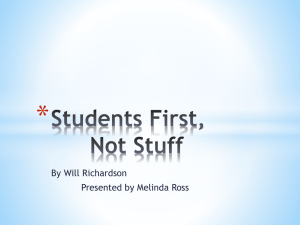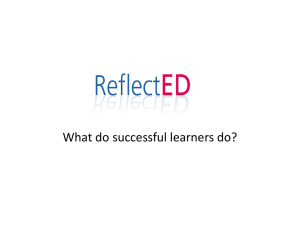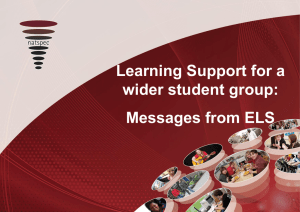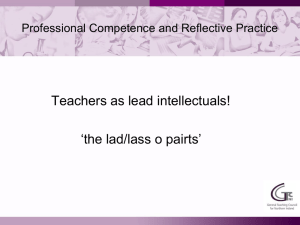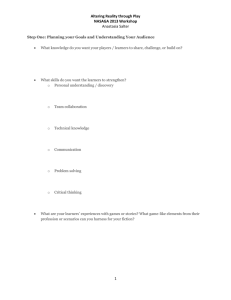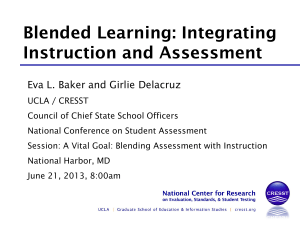PowerPoint Template 5 - Coalition for Community Schools
advertisement
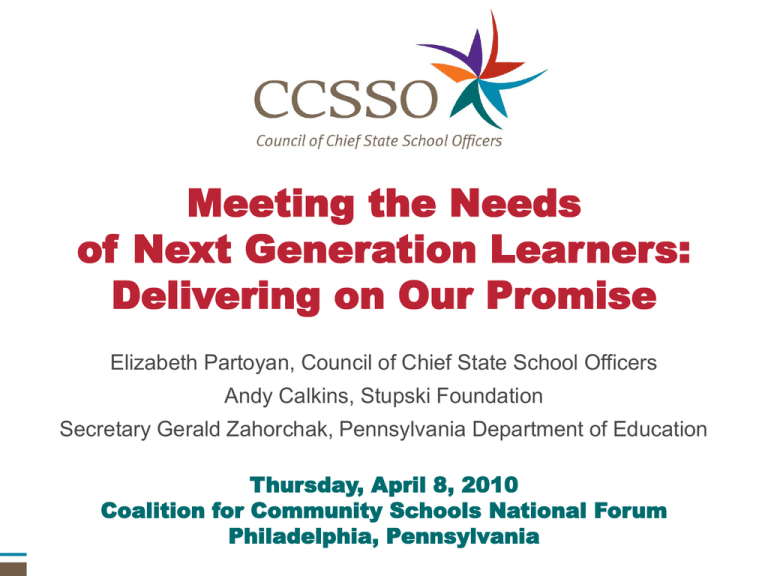
Meeting the Needs of Next Generation Learners: Delivering on Our Promise Elizabeth Partoyan, Council of Chief State School Officers Andy Calkins, Stupski Foundation Secretary Gerald Zahorchak, Pennsylvania Department of Education Thursday, April 8, 2010 Coalition for Community Schools National Forum Philadelphia, Pennsylvania Learning Goals for This Session • To become familiar with the Council of Chief State School Officers’ Transforming Education strategy and Next Generation Learners (NxGL) initiative. • To understand the six critical attributes that undergird the NxGL work and explore how these essential conditions can form the basis of powerful partnerships between a range of stakeholders. • To develop and refine knowledge to leverage local, state, and federal policy to enable NxGL principles within and across learning environments. Building Capacity for Change Using these tools strategies Focusing on key statedriven leverage points Advocacy Standards, Assessment, and Accountability Collective State Action Strategic Partnerships Information Systems and Research Education Workforce Next Generation Learners Delivering on our promise To prepare every child for lifelong learning, meaningful work, and citizenship CCSSO Next Generation Learners Initiative • Goal: To create a personalized system of education that engages and motivates each child—from birth through adolescence, regardless of his or her circumstance—to be prepared for life, meaningful work, and citizenship. • Features: Concentrates on the elements of education that have direct bearing on students and their learning experiences and focuses on learners and learning, rather than on schools and schooling • Alignment: Highly interdependent with the Education Workforce, Information Systems & Research, and Standards, Assessment, & Accountability strategic initiatives NxGL Programmatic Areas • Early childhood: High-quality early educational experiences are essential to ensure that students come to school ready to learn. • Expanded learning opportunities: ELOs provide personalized learning experiences and supports that go beyond the traditional school schedule and transcend place. • Virtual learning: Online learning systems help facilitate anytime, everywhere learning and expand the curriculum. • IDEA Partnership: Moving to a learner-centric system requires understanding of best practices from the education of students with special needs. Critical Attributes of Next Generation Learning • Personalizing Learning • Comprehensive Systems of Learning Supports • World-class Knowledge and Skills • Performance-based Learning • Anytime, Everywhere Opportunities • Authentic Student Voice Sources of the NxGL Attributes • A deepened understanding of learners • Greater knowledge of socio-cultural factors • Recognition that the world has changed The Partnership for Next Generation Learning • To bring our vision of transforming our public education system to reality, CCSSO and the Stupski Foundation have formed an alliance — the Partnership for Next Generation Learning — to establish a network of statebased Innovation Labs. • The NxGL Partnership is the engine that will help states move from their current systems to a new design for public education and influence federal policy to scale, support, and sustain what works. The Innovation Lab Network Innovation Lab Network Lab Lab Lab Lab + Affiliate States The graphic above illustrates what the Labs and Network might look like, with the orange rectangles representing state education agencies, the red ovals representing districts, and the green trapezoids representing schools. Innovation Lab Network Supports • Collective state action to ensure sustainability and support for new system implementation and public will-building. • Information sharing for change through an open-architected knowledge platform to enable the Innovation Labs to learn from new research and one another. • Innovation design expertise from various national and international sectors to co-develop new system designs. • System design tools to assist in the transition to new systems at the state and district levels and to develop change management processes for leaders. • Research development, and dissemination (RD&D) agenda to conduct rigorous analyses of existing examples of next generation learning and synthesize what is learned. “Power in organizations is the capacity generated by relationships." —Margaret J. Wheatley Levels of Interaction Networking: Exchanging information for mutual benefit. Coordination: Exchanging information and altering activities for mutual benefit. Cooperation: Exchanging information, altering activities, and sharing resources for mutual benefit. Collaboration: Exchanging information, altering activities, sharing resources, and initiating new synergistic activities and approaches for mutual benefit. Successful Partnerships… 1. Have clear goals that are derived from the objectives of the partnering entities. 2. Aim to achieve positive results and regularly measure their progress. 3. Are broad-based and include a range of key stakeholders from the beginning. 4. Involve key stakeholders in planning and developing programs and services. 5. Involve powerful champions and make their initiatives visible to the public. Continued Successful Partnerships… 6. Establish clear governance structures that define partner roles and responsibilities. 7. Set and adhere to a set of ground rules that guide the partnership in its work. 8. Adopt an entrepreneurial mindset and adapt to changing conditions and resources. 9. Enable all partners to benefit by drawing on their strengths and contributions. 10.Work to maintain momentum and to sustain their work over time. What Do You Think? For More Information Elizabeth Partoyan Strategic Initiative Director, Next Generation Learners Council of Chief State School Officers 202-336-7019 elizabethp@ccsso.org



